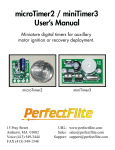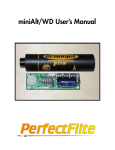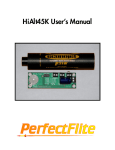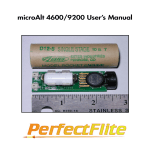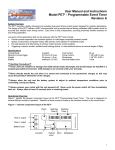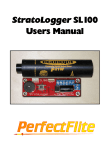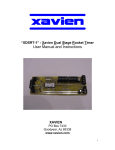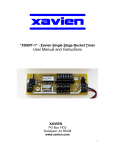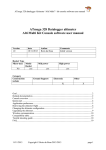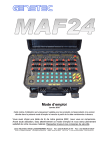Download miniTimer User`s Manual
Transcript
miniTimer User’s Manual A miniature digital timer for auxillary motor ignition or recovery deployment. 15 Pray Street Amherst, MA 01002 Voice (413) 549-3444 FAX (413) 549-1548 URL: www.perfectflite.com Sales: [email protected] Support: [email protected] Congratulations on your purchase of the new miniTimer staging/ ejection timer. Please read these instructions carefully before attempting to use the timer to insure safe and successful operation. The miniTimer can be used in a number of ways: o Ignition of upper stages in multi-stage rockets. The first stage (booster) motor is ignited conventionally on the pad. The timer is triggered as the rocket rises, beginning its timing cycle. After the user-programmed interval (coincident with booster motor burnout), power is applied to the next stage’s ignition system. Electronic ignition of the upper stage allows for staging of composite propellant motors and the use of longer booster sections which are not generally suitable for conventional “burn-through” (gap) staging techniques. o Airstart ignition of auxillary motors in clustered rockets. The main motor is ignited conventionally on the pad, and the timer is triggered as the rocket lifts off. After the programmed time interval additional motors in the cluster are ignited by the timer, providing an extended burn time for greater altitude. o Electronic deployment of recovery devices. The timer is activated at liftoff. After the programmed time interval power is provided to an ejection charge to deploy the parachute. The timer provides a wider range of precise, repeatable delay times than that which is available with the motor’s built-in delay. Keeping an assortment of motors with different delay times is no longer necessary. Since the motor ejection charge is not used, the problem of delay “blow-by” causing premature ejection is eliminated. o Redundant deployment of recovery devices. An altimeter or accelerometer provides the primary recovery system deployment, and the timer ignites an additional ejection charge several seconds “late” as a backup in case of altimeter/accelerometer failure. Features The miniTimer incorporates a number of useful features: o Easy to set delay time The delay time can be quickly set in the field and is reported numerically for confirmation after setup. o Audible continuity indication The igniter circuit is tested while awaiting launch and its continuity status is reported via a built-in beeper. o Automatic trigger sense configuration The timer determines whether a normally-closed trigger switch (e.g. breakwire) or normally-open trigger (e.g. G-switch) is connected and configures itself accordingly. o False trigger filtering The trigger condition must be met for 1/2 second for the timing cycle to initiate. This eliminates false activations due to trigger switch glitches or momentary activation of a G switch. o High current capability The timer can provide over 20 Amps of current continuously, and over 40 Amps for short durations. This allows the use of multiple parallel-connected igniters for clustered airstarts. o High accuracy, nonvolatile setting The user-programmed time delay is derived digitally for repeatable, drift-free performance. The delay setting is stored in nonvolatile EEPROM and is retained even with power off. o Small size, low weight Allows for easy installation in virtually any application. Mounting hardware supplied. Operation When power is applied to the timer it will enter one of two modes depending on the state of the “program” button. If the button is held down when the timer is powered up, it will enter “program” mode to enable the setting of the delay time. If the button is not held down on powerup, normal timer mode will commence. The program button is only sampled at powerup, so pushing the button at any other time will have no effect on the operation of the timer. Program Button Program Mode (setting the delay) If the timer is powered up while the program button is depressed, a confirmation tone will be heard from the beeper. Releasing the program button will stop the tone and prepare the timer for programming. The time delay is then set by holding the button down for a time equal to the desired delay. The beeper will produce a tone while the button is held down to assist in setting the delay. When the button is released, the beeper will sound a long confirmation tone followed by a sequence of beeps representing the saved time delay in tenths of a second. If the delay is set to 1.6 seconds, the beeper will beep out a single beep (1), followed by six beeps (6), or 16 tenths of a second (1.6 seconds). The digit zero is represented by ten beeps, and leading (non-significant) zeroes are suppressed. If the programming button is held down for less than 0.6 seconds (the minimum time delay) or more than 25.5 seconds (the maximum time delay) then the actual saved delay will be set to 0.6 seconds or 25.5 seconds respectively. Normal Operation Mode If the program button is not depressed when the timer is powered up, normal operation mode will be selected. A long tone will sound, followed by a sequence of beeps reporting the preset time delay as described earlier. The beeper then emits a high/low/ high/low tone sequence as it looks at the trigger input to detect the “normal” (untriggered) state. If the trigger switch is open during this period (as in a G-switch trigger), the continuity check will report using a high pitched tone. If the trigger switch is closed (as in a breakwire), the continuity check will report using a low pitched tone. This feature allows the user to confirm that the trigger circuit is configured as expected prior to flight. The continuity check tone will then be emitted until launch conditions are detected. In order to generate a valid launch detect, the trigger condition must be met for a period of 1/2 second without interruption. This prevents wind or vibration induced glitches from prematurely initiating the timing cycle. When a valid launch condition is detected, the continuity check tone will cease and the timer will wait out the remainder of the time delay before applying power to the igniter circuit. The igniter circuit is powered on for a period of one second, and then the timer recycles to the power-up state. Triggering Options The timer can be triggered by a normally closed (shorted) or normally open (unshorted) circuit connecting the two Trigger terminals (labeled “T” on the board). An example of a normally closed circuit is the “breakwire”, which is simply a thin wire connecting these terminals together, with a Internal wiring to timer "T" terminals Connection screws Thin (32-36 guage) break-wire Thick anchor wire (secure bottom end to ground) stronger piece of wire looped around the breakwire and fixed to the ground. When the rocket leaves the pad, tension from the heavier wire snaps the breakwire, opening the normally closed circuit and triggering the timer. Another triggering method involves the use of a pull-pin on a cord staked to the ground, which is then inserted into a switching mechanism such as the normally open contacts of a miniature 1/8” phone jack. When the pin is inserted into the jack, it closes the switch contacts, creating a normally closed condition. When the rocket leaves the pad, the pin is pulled, opening the contacts and triggering the timer. The triggering circuit can be made completely self-contained (no external connections) with the addition of a “G-switch”. This device senses acceleration along its longitudinal axis and closes its contacts when the acceleration exceeds a specific threshold (an ~2G threshold is common in this application). When the rocket experiences 1/2 second of acceleration in excess of this rating, the timer will be triggered. Make sure that Gswitches are oriented in the proper direction–one end (as specified by manufacturer) will have to point in the direction of travel. G-Switch mounted on timer Igniter Selection Recovery Deployment Applications When using the timer for recovery system deployment, the best choices for ejection charge igniters are DaveyFire N28B or Oxral ematches or Christmas tree bulb based charges (PerfectFlite ECK6). These are low voltage, low current devices that provide a short burst of heat to ignite the easily combustible black powder ejection charge. Auxillary Motor Ignition When using the timer to ignite sustainer or airstart motors, longer burning, hotter igniters should be employed. Normal Estes igniters can be used in the smaller black powder motors. Composite motors work well with the DaveyFire N28F ematch (dip the head in pyrogen for extra reliability) or igniters made by dipping leadwires in conductive primer and auxillary pyrogen. The DaveyFire match heads are too large to fit in the nozzle throat of smaller composite motors, and therefore are generally used only in 38mm or larger motor sizes. Aerotech FirstFire igniters can also be used, but will require a more powerful (larger) battery. Battery Guidelines Igniters are basically small electric heaters that consume a relatively large amount of power (compared to the timer itself). The battery must be able to supply enough power to fire the igniter without having its terminal voltage fall below the timer’s minimum voltage spec of 3.6 volts. In order to guarantee reliability of the entire system, you must match the characteristics of the battery and the igniter(s) used. Calculating Igniter Current Requirements The current demand of a particular igniter/battery combination can be determined relatively easily using Ohm’s Law, which states that current (I) is equal to voltage (V) divided by resistance (R). Igniter resistance is frequently specified by the igniter manufacturer, and can also be measured with a multimeter set to a low resistance range. Some representative igniter resistances are listed below. The nominal open-circuit voltage of the battery is easily determined, but we must remember that the voltage will drop under load due to the battery’s internal resistance. If you try to draw 20 amps from a 9V battery, the battery’s voltage will drop to next to nothing. NiCad batteries tend to have the lowest internal resistance and keep their voltage up well under load. Nickel Metal Hydride (NiMH) batteries have high internal resistance and should be avoided in this application. Use Ohm’s Law (I=E/R) to determine the current demand of the chosen igniter. If you are using multiple igniters in parallel (for clustered applications) the current demand of each igniter must be multiplied by the number of igniters used. Once the total current draw is determined (not to exceed the current rating of the timer), an appropriate battery can be specified. Choose a battery that will be able to supply the required current while maintaining the necessary voltage. Note that even the “low current” ematches draw a lot of current at higher voltages due to their low resistance. Common 9 volt batteries are not well suited for this application! Igniter Type Resistance Firing Current* DaveyFire..............................1.6Ω ............................1.0A (N28F) Oxral......................................2.0Ω ............................0.5A Estes.......................................0.6Ω ............................2.0A FirstFire .................................0.8 Ω ............................4.0A Dipped...................................5Ω - 15Ω .....................varies (~0.5A to 2A) * Higher applied current will result in faster ignition and shorter duration of current flow. Battery Type Nom. V V@2A V@5A V@10A V@20A 9V alkaline .....................9.3V ........3.1V ........–––– ........–––– ........–––– “9V” 7 cell NiCad .........9.1V ........4.5V ........0.6V ........–––– ........–––– “9V” N6PT NiCad ........7.7V ........6.9V ........5.6V ........2.9V ........0.8V 4 cell 2/3AA NiCad......5.4V ........5.1V ........4.4V ........3.3V ........1.6V 4 cell 2/3A NiCad.........5.4V ........5.1V ........4.7V ........4.0V ........2.8V 6 cell sub-C NiCad........8.1V ........7.9V ........7.6V ........7.1V ........6.2V Igniter Fabrication Dipped igniters can be created easily in the following manner. The resulting igniters will fire on a standard 9V NiCad battery, drawing less than 2 amps of current. You should test-fire a number of igniters in a fireproof, well-ventilated area to perfect your fabrication technique before relying on them for use in flight. A. B. Prepare the leadwires. For larger nozzle motors, standard 24 gauge solid conductor twinlead is inexpensive and durable. For smaller throat motors (E11, E15, and even smaller) the best choice is 30 gauge Kynar insulated wire-wrap wire. The wire-wrap wire needs to be twisted into a two-conductor cable before proceeding. This is easily done by chucking two lengths of the wire in an electric drill and twisting until a reasonably tight twist is created. Make up 10 or 20 feet at a time, and cut it into ~12” long sections for igniters. Strip approximately 1/32”-1/16” insulation from the active end of the leadwire (the end that will be dipped) and 1/2” insulation from the other end (for connection to the timer). Dip the active end of the leadwire in conductive primer (FireFox ELV Conductive Primer or similar). The primer should be stirred thoroughly before each dipping session, and thinned with acetone to achieve a thick syrup-like consistency. You don’t need much primer, a small bead covering the stripped ends is fine. If you use too much primer, it will ignite with a “pop” when fired, which can blow the second dip of pyrogen off without igniting it. After dipping the leads in primer, allow the primer coat to dry for several hours before proceeding. When dry, the igniter resistance (measured between the 1/2” stripped lead ends) should be in the range of 5Ω to 20Ω. If the resistance is out of range, cut off the dipped end and try again. This shouldn’t happen often, achieving a good primer dip isn’t hard. C. Dip the primed end in pyrogen (FireFox PyroMag Pyrogen or similar). The pyrogen should be stirred and thinned as with the primer (if it becomes lumpy, try adding a bit of Methyl Ethyl Ketone to dissolve the lumps). You will want to adjust the consistency of the pyrogen to match the desired application -- narrow igniters for smaller motors should be dipped using thinner pyrogen, and bigger igniters will be created with a thicker consistency. Dip the leads to a depth of approximately 1”, wiggling the lead as you withdraw it from the pyrogen to keep a large lump from forming on the end. Set the dipped igniters aside to dry overnight. Making dipped igniters Installation and Connections Use the supplied 4-40 hex standoff and hardware to mount the timer. The timer can be attached directly to the inside of the airframe tubing, with an extra hole drilled through the airframe adjacent to the mounting screw for access to the programming switch. The timer can also be attached to a mounting plate or bulkhead inside the rocket. Make sure that your mounting scheme does not preclude access to the programming switch. If you are using a G-switch trigger, make sure that the G-switch is facing in the proper orientaion. When installing the miniTimer model equipped with connectors, the maximum load current should be limited to 5 Amperes. Higher current applications should be wired directly to the holes provided on the circuit board with 22 gauge wire. Use care when soldering to the board to prevent solder bridges or damage to the surface mount components. Observe proper polarity when connecting the battery. If reverse voltage is applied, the FET array’s body diodes will conduct, resulting in immediate firing of any attached igniters. If power is applied before attaching igniters (as is recommended in the operational checklist), proper polarity will be confirmed by the power-up beep sequence. Improper polarity will result in silence. Try to keep the wiring lengths to a minimum to reduce voltage drops due to wiring resistance. The battery should be mounted as far forward as possible for least impact on the CP/CG relationship. Make sure that the timer, battery, and wiring do not interfere with the proper deployment of the recovery devices, and keep the timer out of the path of potentially corrosive ejection gasses. Always test a new installation before launching. Set up the timer normally, substituting a dummy load such as a light bulb for the igniter. Run through the checklist and confirm that the delay is as desired and that the bulb comes on at the end of the time interval. Testing with an igniter of the type that will be used in the real application (but not installed in an engine or ejection charge) will confirm that the battery has enough power to fire the igniter. Power Switch To Igniter miniTimer without connectors Brown Wire Battery Red Wire Battery + Blue Wires To Trigger Switch Yellow Wires To Igniter miniTimer with connectors Cautions • Do not connect or install any igniters into rocket engines until rocket is out of the prep area and on the pad. • When retrieving a rocket that did not fire all of its motors, remove the igniters from any live motors before handling or transporting the rocket. • Do not touch circuit board traces or components or allow metallic objects to touch them when the timer is powered on. This could cause damage to your timer or lead to premature ejection charge deployment or motor ignition. • Exercise caution when handling live ejection charges - they should be considered to be explosive devices and can cause injury or damage if handled improperly. • Do not allow the timer to get wet. Only operate the timer within the environmental limits listed in the specifications section. • Check battery voltage and polarity before connecting to the timer. • Always follow proper operational sequencing as listed in preflight checklist. Operational Checklist ❏ Insure that power is OFF or battery is disconnected. ❏ Connect external breakwire or install pull-pin as necessary, or confirm that G switch or other internal trigger mechanism is connected properly. ❏ Turn power switch ON. Listen for proper powerup report of time delay setting. This will also confirm proper battery connection and polarity. Turn power switch OFF. ❏ Connect igniter or ejection system to igniter leads from timer. ❏ Turn power switch ON. Wait for the powerup tone sequence to finish and verify that the proper continuity tone is present. ❏ Launch! Specifications miniTimer dimensions: weight: operating voltage: operating current: firing current: continuity check current: trigger: timing range: timing accuracy: operating temperature: 0.65”W x 1.25”L x 0.55”T 4 grams 3.6V to 10.0V 1.5 mA maximum 47.6A for 10ms, 22.4A for 1 second 45µA/V normally-open or normally-closed 0.6 second to 25.5 seconds +/- 5% typical 0°C to 70°C Maximum recommended current for connectorized version is 5 Amperes. Higher current applications should be wired directly. Igniter Sources Estes Industries. ............................................................. EST2301 Igniter 1295 H Street Penrose, CO 81240 Countdown Hobbies (dealer) 7 P.T.Barnum Sq. Bethel, CT 06801-1838 (203)790-9010 www.countdownhobbies.com FireFox Enterprises.................................................. ELV, Pyromag (kits) P.O. Box 5366 11612 N. Nelson Pocatello, ID 83202 (208) 237-1976 www.firefox-fx.com Luna Tech.......................................................................................... Oxral 148 Moon Drive Owens Cross Roads, AL 35763 (256) 725-4224 www.pyropak.com Daveyfire............................................................................... N28B, N28F 7311 Greenhaven Drive, Suite 100 Sacremento, CA 95831-3572 (916) 391-2674 http://www.daveyfire.com/html/electricinitiation.htm Performance Hobbies (dealer) 442 Jefferson Street NW Washington, DC 20011-3126 (202) 723-8257 www.performancehobbies.com Warranty All assembled Perfectflite products include a full three year/36 month warranty against defects in parts and workmanship. All Perfectflite kits include a full three year/36 month warranty against defects in factory-supplied parts. Should your Perfectflite product fail during this period, call or email our Customer Service department for an RMA number and information about returning your product. The warranty applies to the timer only, and does not cover the rocket, motor, or other equipment. This warranty does not cover damage due to misuse, abuse, alteration, or operation outside of the recommended operating conditions included with your product. Liability Due care has been employed in the design and construction of this product so as to minimize the dangers inherent in its use. As the installation, setup, preparation, maintenance, and use of this equipment is beyond the control of the manufacturer, the purchaser and user accept sole responsibility for the safe and proper use of this product. The principals, employees, and vendors of the manufacturer shall not be held liable for any damage or claims resulting from any application of this product. If the purchaser and user are not confident in their ability to use the product in a safe manner it should be returned to the point of purchase immediately. Any use of this product signifies acceptance of the above terms by the purchaser and user.
















